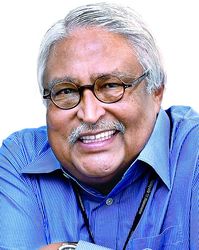
A FEW YEARS ago, a relative of mine philosophically said, “At any point in life, there is always someone thinner than you, and someone richer.” I could not resist taking a dig: “I am surprised it took you so long to realise that.”
Jokes apart, I have always felt that this ‘Who is thinner/richer/prettier?’ game is quite unproductive. Writer Antoine de Saint-Exupéry sums it up in one line: “Grown-ups love figures.” I think he meant both figures—numbers and the human form. In The Little Prince, he writes: “When you tell [grown-ups] you’ve made a new friend they never ask you any questions about essential matters. They never say to you ‘What does his voice sound like? What games does he love best? Does he collect butterflies?’ Instead they demand, ‘How old is he? How much does he weigh? How much money does his father make?’”
One of the more discussed books in the past month has been Elizabeth Currid-Halkett’s The Sum of Small Things (Princeton University Press, 2017). She was seen as offering an update to Thorstein B. Veblen’s classic, The Theory of the Leisure Class (1899). In this book, the Norwegian-American economist and sociologist introduced the phrase “conspicuous consumption”. Simply put, he said people bought expensive things to show off their wealth. That trend is waning among the wealthy, says Currid-Halkett. She says that class is now looking at an investment in social capital. And, this is something they are passing on to their children.
For example, yoga or organic food. Parents who are convinced about the benefits of these will pass them on their children. The child will benefit from this physically and mentally. And, this child could have an advantage over children who have not had a similar grounding. Here, wealth is used to give a different head start. Interesting concept, I thought, using the material to attain a certain spiritual grounding. More interesting to me was the fact that both Veblen and Currid-Halkett refer to Indian concepts in their books.
This issue is our annual Mid-Year Special, and the theme is Hindu spirituality abroad. At a time of international turmoil, refugee crisis and xenophobia, we take a look at how our philosophies have fared abroad. I personally have tried to meditate and look into myself, unsuccessfully. My wife, Bina, says that it is perhaps the hangover of my life as a newspaper journalist. Once the edition goes to print, no amount of thinking is going to undo the errors in judgment or copy. The worst way to spend the night would be to spend it thinking about what could have been. So, I sleep it off and take the next day as it comes. There is a ‘let go’ factor in my method, I am told. Then, perhaps, I am unintentionally meditative!
And, sometimes I find it difficult to separate the spiritual and the material/physical. In this issue, we have a feature on the latest venture of a musical couple, Kavita Krishnamurthy and Dr L. Subramaniam. As our families have been close, I found myself thinking about Kavita’s brother-in-law and my batch-mate, Shamsher Singh Ahlawat. His brother, Captain Badan Singh Ahlawat, died in an avalanche in Kashmir in the early 1960s. This happened while their father (later Haryana assembly speaker) Brigadier Ran Singh was commanding a brigade in the same area.
The captain’s body was recovered after three months. To this day, Shamsher has, and often wears, the watch his brother wore in death. Now, tell me, is the watch a mere physical object? To the brother, doesn’t the piece of metal have a deeper, spiritual connect?





